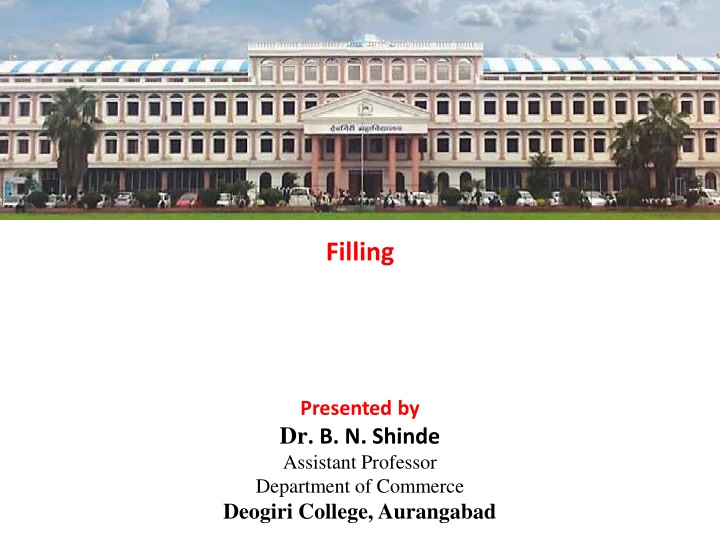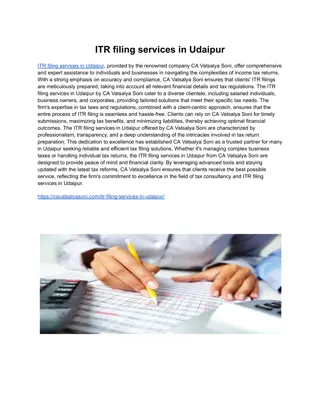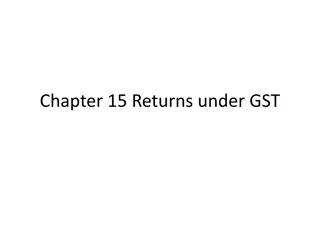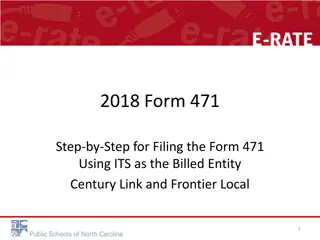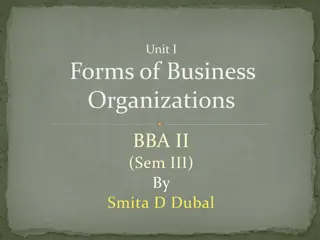Comprehensive Guide to Filing in Business Organizations
Filing is essential for maintaining records in business organizations. It involves systematic arrangement of documents for easy access and reference. The objectives, functions, and importance of filing are discussed in this informative guide.
Download Presentation

Please find below an Image/Link to download the presentation.
The content on the website is provided AS IS for your information and personal use only. It may not be sold, licensed, or shared on other websites without obtaining consent from the author.If you encounter any issues during the download, it is possible that the publisher has removed the file from their server.
You are allowed to download the files provided on this website for personal or commercial use, subject to the condition that they are used lawfully. All files are the property of their respective owners.
The content on the website is provided AS IS for your information and personal use only. It may not be sold, licensed, or shared on other websites without obtaining consent from the author.
E N D
Presentation Transcript
Filling Presented by Dr. B. N. Shinde Assistant Professor Department of Commerce Deogiri College, Aurangabad
What is filing ? Introduction: A large number of records can not be preserved and handled without proper arrangement. Such proper arrangement is called filing. The top executives can plan on the basis of past performance and records. Hence, a systematic preservation of various types of information for various purposes is made possible only by a good filing system. Filing is a form of record keeping. Documents are filed in such a way that they may be available whenever required. This is the main purpose of record keeping.
Conti Filling is a means of preservation of documents relating to business transactions. Filing is defined as systematic arrangements of business documents and papers in such way that will be highly convenient in locating and delivering such documents and papers when needed for future reference to the needy persons.
Objectives of Filing The main objectives of filing are presented below. 1. Proper arrangement of records. 2. Proper sorting and storing of records. 3. Easy availability of records.
Functions of Filing with the proper sorting and storing of records but also concerned with systematic arrangements of records so that they can be easily found and transacted when required for. In this way, the filing performs the following functions. 1. Library Function: It is the process of sorting and arranging the records for future reference 2. Administrative Function: It is the process of maintaining and supplying the various documents for framing business policies. The process of filing is not only concerned
Conti 3. Information Function: It is the process of protecting the various types of relevant information for various purposes. 4. Historical Function: It is the process of preservation of information in a systematic manner in such a way that will disclose the business organization.
Importance of filing It helps in increasing efficiency of office because filing helps in providing records in required time to make quick decisions Filing helps in protection of important documents from fire, dust, insects, theft and mishandling. Previous records are base of past records, and they are used as an immediate reference.
Importance of filing It helps in documentation of proof and legal evidence in the time of disputes It helps in formulation of future planning It helps in providing legal proofs to fulfill legal formalities. It helps in handling correspondence carefully to maintain the goodwill of the office It helps in taking feedback. customers and
Essentials of Good filing 1. Compactness: The compact filing system should be adopted by every business office. It means that the filing system should not require any unnecessary space. 2. Simplicity: The filing system should be simple and not too elaborate. At the same time, the usefulness of the filing system cannot be sacrificed for the sack of simplicity.
Essentials of Good filing 3. Accessibility: A good filing system should be arranged in such a way that the records are easily available whenever required. The filing system should allow the insertion of additional documents without disturbing the existing order of files. 4. Economy: The filing system should be economical in time, space, money and operations. The cost of installation and operation of filling system should be as low as possible. The selected filing equipment should occupy minimum space but can accommodate maximum number of files. The cost of filing equipment should be very low. The filing equipment save the time of operation i.e. locating, inserting and placing of documents and papers in a file. The unwanted records may be disposed of in order to economies space.
Essentials of Good filing 5. Flexibility: The filing system can be expanded if the volume of business transactions increased. An inflexible system is not useful after crossing a certain limit. 6. Classification: The filing system should be supported by a proper system of classification. Proper classification reduces the number of files to be maintained and helps in inserting as well as locating the documents in the files. 7. Safety: The filed documents and records should be in safe condition and available whenever required. The documents and records should be protected from insects, rain, dust, or mishandling.
Essentials of Good filing 8. Cross Reference: A cross reference should be given wherever a document can be filed more than one head to avoid confusion and facilitates easy location of files. It saves time and human resources. 9. Easy Location: Documents and records should be kept in such a way that they can be easily located whenever required with the minimum delay possible. At the same time, it does not require heavy expenditure to achieve this purpose. 10. Indexing: A well designed index is also used to supplement the filing system. It will help to locate the file quickly when it is required.
Essentials of Good filing 11. Retention: Every documents and records are maintained for a minimum period of time. Then, the dead records and documents can be discarded without too much disturbance. The remaining documents and records are retained even after a storage period. 12. Out guides: A reference is to be maintained in the files that the list of documents or records are withdrawn by the office staff or department and returned the documents with date. Rules and procedures can be framed and followed to prevent misfiling. 13. Minimum Misfiling: The main difficulty is not concerned with filing but in finding the documents. Misfiling causes delay in the location of desired document. Hence, the authorized staff alone is permitted to have access to files.
System of classification of filing 1. Alphabetical Topical Filing Systems Alphabetical topical systems classify information according to topic, then file the topic labels in alphabetical order. Related topics are not kept together in this system. Usually this type of system is best when small amounts of information are involved. This type of filing and classification system is sometimes known as a "dictionary" system. When personal names are being filed, last names are used as the primary sorter, with first names used only in the case of identical last names. 2. Alphabetical Encyclopedia Filing Systems In an "encyclopedia" filing and classification system, information is first broken down by general category, with sub-categories being placed in alphabetical order. This type of filing system is particularly useful for handling large amounts of information because users of the system don't have to keep a particular file's name in mind to find it. Instead, they can start by looking for the general category and search within it to find the specific file they need.
System of classification of filing 3. Duplex Numeric Filing Systems In duplex numeric filing systems, files are given numeric labels with several sets of numbers involved. This type of filing system can handle large amounts of data. The different sets of numbers can correspond to major categories and sub-categories, paralleling the encyclopedia system of filing and classification. One drawback to such a system is that an index is required to understand what each grouping of numbers refers to. A very familiar type of duplex numeric system is the Dewey Decimal system, which most libraries use to catalog their collections. 4. Chronological Filing Systems Another subcategory of numeric filing systems are chronological systems, in which files arranged by date. Typically files are first grouped by year, then by month, then by day. Correspondence files, such as email lists, are typically organized in this fashion, with the most recent pieces of data listed first.
System of classification of filing 5. Alphanumeric Filing Systems In alphanumeric filing systems, information is classified by category in an encyclopedic system, but using both letters and numbers to denote categories. The use of both letters and numbers allows for a much greater field of categories than does the use of numbers alone.
